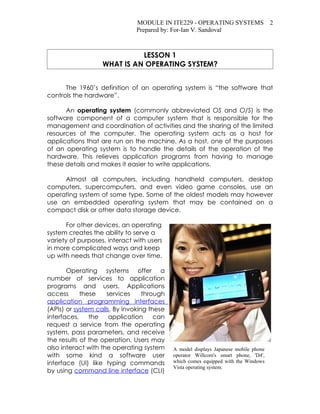
Lesson 1 What Is An Operating System
- 1. MODULE IN ITE229 - OPERATING SYSTEMS 2 Prepared by: For-Ian V. Sandoval LESSON 1 WHAT IS AN OPERATING SYSTEM? The 1960’s definition of an operating system is “the software that controls the hardware”. An operating system (commonly abbreviated OS and O/S) is the software component of a computer system that is responsible for the management and coordination of activities and the sharing of the limited resources of the computer. The operating system acts as a host for applications that are run on the machine. As a host, one of the purposes of an operating system is to handle the details of the operation of the hardware. This relieves application programs from having to manage these details and makes it easier to write applications. Almost all computers, including handheld computers, desktop computers, supercomputers, and even video game consoles, use an operating system of some type. Some of the oldest models may however use an embedded operating system that may be contained on a compact disk or other data storage device. For other devices, an operating system creates the ability to serve a variety of purposes, interact with users in more complicated ways and keep up with needs that change over time. Operating systems offer a number of services to application programs and users. Applications access these services through application programming interfaces (APIs) or system calls. By invoking these interfaces, the application can request a service from the operating system, pass parameters, and receive the results of the operation. Users may also interact with the operating system A model displays Japanese mobile phone with some kind a software user operator Willcom's smart phone, 'D4', interface (UI) like typing commands which comes equipped with the Windows Vista operating system. by using command line interface (CLI)
- 2. MODULE IN ITE229 - OPERATING SYSTEMS 3 Prepared by: For-Ian V. Sandoval or using a graphical user interface (GUI, commonly pronounced “gooey”). For hand-held and desktop computers, the user interface is generally considered part of the operating system. On large multi-user systems like Unix and Unix-like systems, the user interface is generally implemented as an application program that runs outside the operating system. (Whether the user interface should be included as part of the operating system is a point of contention.) Common contemporary operating systems include Microsoft Windows, Mac OS, Linux and Solaris. Microsoft Windows has a significant majority of market share in the desktop and notebook computer markets, while servers generally run on Linux or other Unix-like systems. Embedded device markets are split amongst several operating systems. There are hundreds of other operating systems available for special-purpose applications, including specializations for mainframes, robotics, manufacturing, real-time control systems and so on. In any device that has an operating system, there's usually a way to make changes to how the device works. This is far from a happy accident; one of the reasons operating systems are made out of portable code rather than permanent physical circuits is so that they can be changed or modified without having to scrap the whole device. For a desktop computer user, this means you can add a new security update, system patch, new application or even an entirely new operating system rather than junk your computer and start again with a new one when you need to make a change. As long as you understand how an operating system works and how to get at it, in many cases you can change some of the ways it behaves. The same thing goes for your phone, too. Not all computers have operating systems. The computer that controls the microwave oven in your kitchen, for example, doesn't need an operating system. It has one set of tasks to perform, very straightforward input to expect (a numbered keypad and a few pre-set buttons) and simple, never-changing hardware to control. For a computer like this, an operating system would be unnecessary baggage, driving up the development and manufacturing costs significantly and adding complexity where none is required. Instead, the computer in a microwave oven simply runs a single hard-wired program all the time.
